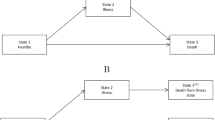Abstract
Modelling patient flow in health care systems is considered to be vital in understanding the operational and clinical functions of the system and may therefore prove to be useful in improving the functionality of the health care system, and most importantly provide an evidence based approach for decision making, particularly in the management of the system. In this paper, we introduce a nonproportional cumulative odds random effects model for patient pathways by violating the proportional assumption of the cumulative odds model. Using the probability integral transform, we have extended this to cases where the random effects are not normal, specifically gamma and exponentially distributions. Some of the advantages of this is that these models depict changes in wellbeing (frailties) of patients as they move from one stage of care to the other in time. This is an hybrid extension of our earlier work by jointly including pathways and covariates to explain probability of transition and discharge, which could easily be used to predict the outcome of the treatment. The models here show that the inclusion of pathways render patients characteristics as insignificant. Thus, pathways provide a source of useful information about transition and discharge than patient characteristics, especially when the model is applied to a London University Neonatal Unit dataset. Bootstrapping was then used to investigate the stability, consistency and generalizability of estimated parameters from the models.
Similar content being viewed by others
References
Adeyemi S, Chaussalet TJ (2008) A random effetcs sensitivity ananlysis for patient pathways model. In: Proceedings of the 21st IEEE symposium in computer based medical systems 536–538
Adeyemi S, Chaussalet TJ (2009) Models for extracting information on patient pathways. In: McClean S, Millard PH, El-Darzi E, Nugent CD (eds) Intelligent patient management. Studies in computational intelligence (189). Springer, pp 171–182. ISBN 9783642001789
Adeyemi S, Chaussalet TJ, Xie H, Assaduzaman M (2010) Random effects modelling of operational patient pathways. J Appl Stat 37(4): 691–701
Akaike H (1974) A new look at the statistical model identification. IEEE Trans Autom Control 19: 716–723
BLISS (2005) Neonatal Services-are they improving, BLISS-The Premature Baby Charity
Cote MJ, Stein WE (2007) A stochastic model for a visit to the doctor’s office. Math Comput Model 45: 309–323
El-Darzi E, Vasilakis C, Chaussalet T, Millard PH (1998) A simulation modelling approach to evaluating length of stay, occupancy, emptiness and bed blocking in a hospital geriatric department. Health Care Manag Sci 1: 143–149
Faddy MJ, McClean SI (1999) Analysing data on lengths of stay of hospital patients using phase-type distributions. Appl Stoch Models Bus Ind 15: 311–317
Harrison GW, Millard PH (1991) Balancing acute and long term care—the Mathematics of throughput in departments of geriatric medicine. Methods Inf Med 30: 221–228
Hedeker D, Meermelstein RJ (1998) A multilevel thresholds of change model for the analysis of stages of change data. Multivar Behav Res 33: 427–455
Irvine V, Mcclean S, Millard PH (1994) Stochastic models for geriatric inpatient behavior. IMA J Math Appl Med Biol 11: 207–216
Kulinskaya E, Kornbrot D, Gao H (2005) Length of stay as a performance indicator: robust statistical methodology. IMA J Manag Math 16: 369–381
McClean S, Millard PH (1993) Patterns of length of stay after admission in geriatric medicine: an event history approach. Statistician 42: 263–274
McClean S, Garg L, Meenan B, Millard PH (2007) Using Markov models to find interesting patient pathways. In: Proceedings of the 21st IEEE symposium in computer based medical systems 713–718
McCullagh P (1980) Regression models for ordinal data (with discussion). J Roy Stat Soc Ser B 42: 109–142
Millard PH, Rae B, Wendy B (2009) Why nosokinetics? Measuring and modelling the process of care, In: McClean S, Millard PH, El-Darzi E, Nugent CD (eds) Intelligent patient management. Studies in Computational Intelligence (189). Springer, pp 127–146, ISBN 9783642001789
Pinhero JC, Bates DM (1995) Approximations to the log-likelihood function in the nonlinear mixed-effects models. J Comput Graph Stat 4: 12–35
Schwarz G (1978) Estimating the dimension of a model. Ann Stat 6: 461–464
Tuerlinckx F, Rijmen F, Verbeke G, Boeck PD (2006) Statistical inference in generalised linear mixed models: a review. Br J Math Stat Psychol 59: 225–255
Author information
Authors and Affiliations
Corresponding author
Rights and permissions
About this article
Cite this article
Adeyemi, S., Chaussalet, T. & Demir, E. Nonproportional random effects modelling of a neonatal unit operational patient pathways. Stat Methods Appl 20, 507–518 (2011). https://doi.org/10.1007/s10260-011-0174-z
Accepted:
Published:
Issue Date:
DOI: https://doi.org/10.1007/s10260-011-0174-z




